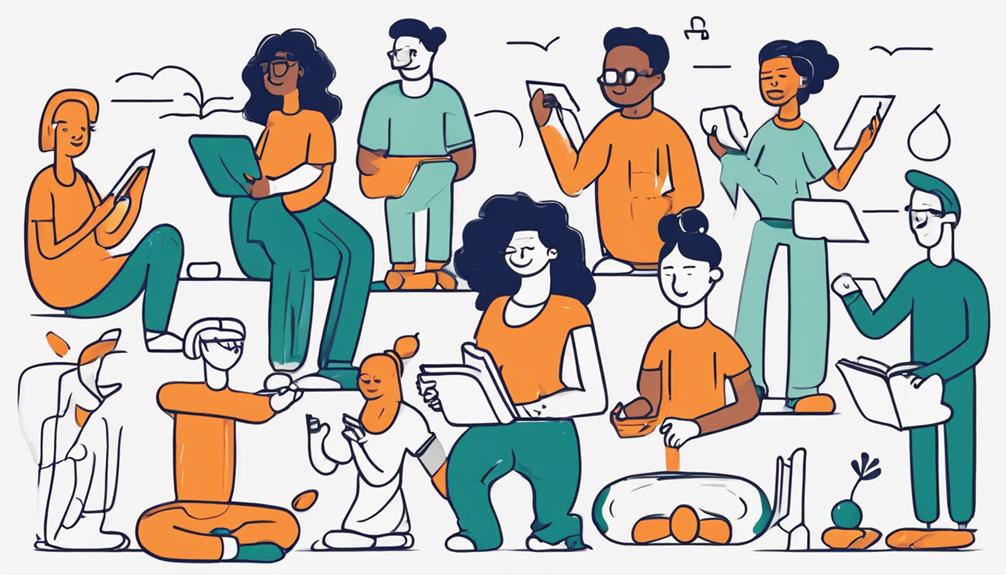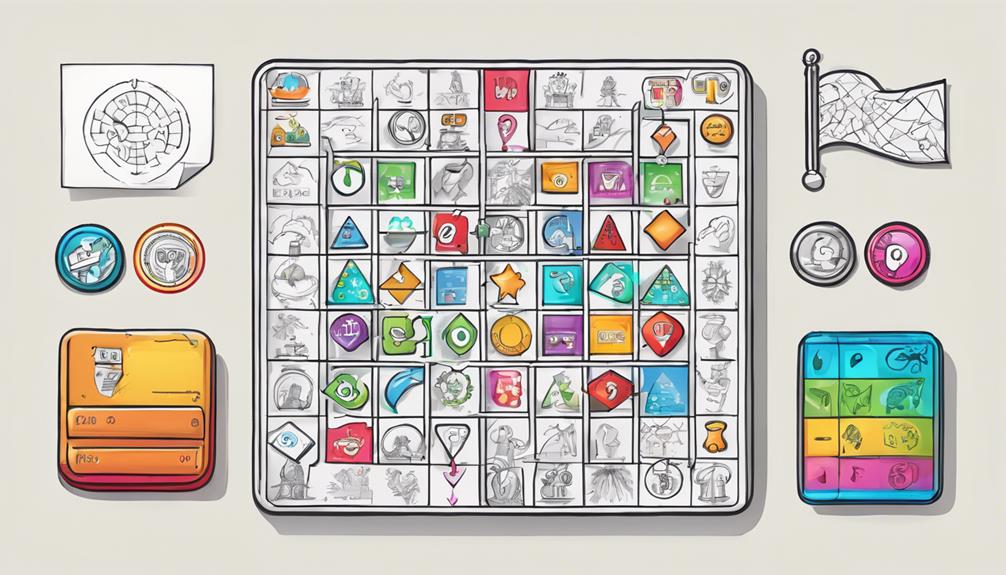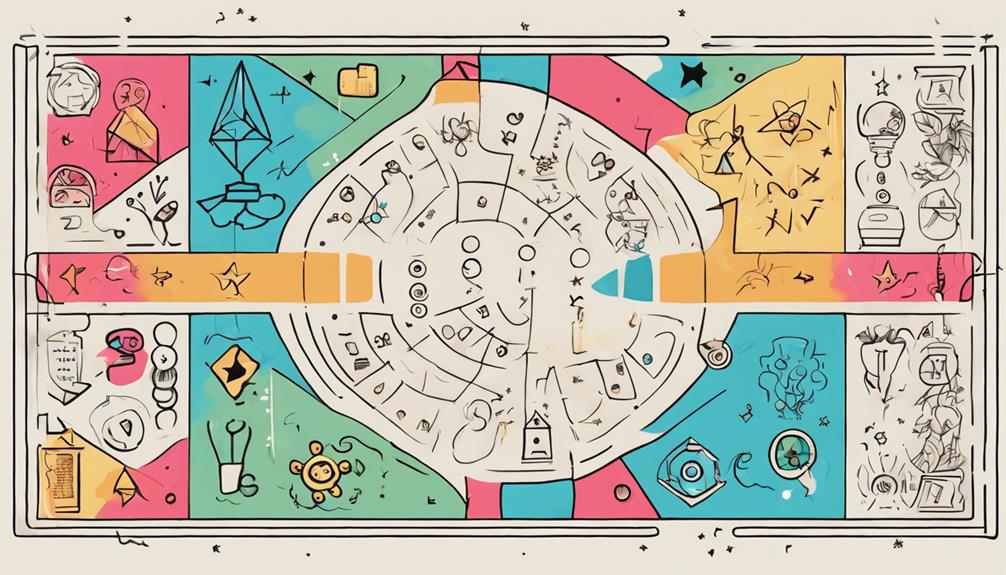Ready to level up your self-improvement game? Plunge into the world of gamification! It's the secret sauce to make growth fun and engaging. Challenge yourself, earn rewards, and track progress like a pro. With interactive elements like points, badges, and levels, personal development becomes a thrilling adventure. Gamified apps and platforms bring a whole new level of excitement to your growth journey. Curious to uncover more ways to make self-improvement playful?
Key Takeaways
- Integrate challenges, points, and rewards for playful self-improvement experiences.
- Use badges and progress tracking to enhance motivation in personal development.
- Foster social connectivity through competition and rewards in growth journeys.
- Transform learning paths with personalized content and skill-based rewards.
- Make self-improvement enjoyable through gamification, balancing tech convenience with growth goals.
Evolution of Gamification in Self-Improvement
Over the past decade, gamification in self-improvement has evolved greatly, incorporating interactive game elements to enhance user engagement and motivation.
Personal development has been revolutionized by the infusion of game elements like challenges, points, and rewards, transforming the journey into a playful and enjoyable experience.
Gamified self-improvement apps and platforms now employ techniques such as levels, badges, and progress tracking to make the process more interactive and rewarding for individuals seeking growth.
Lifestyle Transformation Through Gamification

Transform your daily routines and habits into engaging games through lifestyle transformation with gamification. By incorporating gamification techniques into activities like language learning, fitness tracking, or educational pursuits, you can enhance your personal growth journey while having fun.
Apps such as Zombies, Run! and DuoLingo leverage game elements like rewards, levels, and challenges to make learning and staying active enjoyable. Platforms like Khan Academy offer interactive educational experiences with game-like features to engage users of all ages in continuous learning.
Gamification in lifestyle activities goes beyond mere task completion; it fosters social connectivity through competition, rewards, and personalized experiences. Imagine challenging your friends to language learning duels or earning badges for completing fitness milestones.
Leveraging Smartico.ai for Growth

Looking to level up your business growth? Smartico.ai offers a treasure trove of benefits, from engaging challenges to personalized experiences.
By implementing their gamification strategies, you can boost customer engagement, loyalty, and gain valuable insights for your business.
Smartico.ai Benefits Overview
Utilizing Smartico.ai's gamification platform can greatly enhance customer engagement and loyalty through challenges, points, badges, and incentives. By leveraging player analytics and machine learning, this platform not only boosts customer motivation but also provides valuable insights for business growth. Smartico.ai's multi-currency and language options, along with deep brand integration, cater to diverse business needs, making it a versatile tool for various industries.
In specific sectors like iGaming and sports betting, Smartico.ai stands out by integrating cutting-edge technologies to elevate customer engagement levels. Additionally, products such as Loyalty Wheel, Scratch & Catch, Tournaments, and Marketplace offer tailored solutions for achieving different business objectives effectively.
If you're looking to up your game in customer engagement and drive business growth, Smartico.ai's gamification features and resources, like the #CleverfromSmartico series, are here to provide you with the competitive edge you need while making the journey fun and rewarding.
Implementing Gamification Strategies
How can you leverage Smartico.ai's gamification platform to drive growth and enhance customer engagement effectively?
By implementing gamification strategies through Smartico.ai, you can revolutionize the way you interact with your audience. Smartico.ai offers a robust platform that incorporates challenges, incentives, and gaming techniques to keep users engaged.
With support for multiple currencies, languages, and seamless brand integration, you can create engaging experiences that resonate with your customers.
Utilizing features like missions, points, badges, levels, and incentives, Smartico.ai empowers you to boost customer loyalty and retention. Whether you're in the iGaming, casino, or sports betting industries, Smartico.ai's player analytics and machine learning integration can provide valuable insights for optimizing performance.
Products such as gamification, Loyalty Wheel, Scratch & Catch, Tournaments, and Marketplace cater to diverse business needs, offering a comprehensive suite of tools for enhancing customer engagement and driving growth.
Embrace the power of gamification through Smartico.ai and watch your business flourish in exciting new ways!
Integrating Gamification in Training Programs

Enhance your training programs by incorporating gamification to boost participant engagement and learning outcomes. By including game-like elements, you can significantly improve motivation levels and overall participation.
Here's how you can maximize the impact of gamification in your training programs:
- Utilize Digital Rewards: Implementing digital rewards such as badges and certificates can act as powerful motivators, driving participants to complete tasks and modules with enthusiasm.
- Incorporate Personalized Learning Paths: Offering personalized learning paths based on individual progress and performance can make the training experience more tailored and engaging for each participant, ultimately leading to higher retention rates.
- Enhance Engagement with Game-Like Elements: Integrate quizzes, points, and leaderboards to create a competitive yet collaborative environment that encourages active participation and boosts overall learning outcomes.
Enhancing Learning With Gamification Elements

Let's chat about how gamification can level up your learning experience with points and skill-based rewards.
By personalizing your learning path and earning rewards based on your skills, you'll stay engaged and motivated to grow.
Learning Path Personalization
Personalizing learning paths with gamification elements enhances engagement and tailors educational experiences to individual preferences and needs. When it comes to enhancing learning through personalized paths, consider the following:
- Tailored Content:
By offering personalized challenges and content that align with your interests and progress, your engagement levels are bound to skyrocket. Personalized quizzes and exercises keep you motivated and excited to learn more.
- Adjustable Feedback:
Tracking your progress and providing personalized feedback ensures that you stay on the right learning path. This constant feedback loop keeps you motivated and helps you improve steadily.
- Inspirational Rewards:
Points, badges, and leaderboards aren't just for show; they serve as tangible rewards for your accomplishments. These gamification elements inject fun and motivation into your learning journey, making the process enjoyable and fulfilling.
Skill-Based Rewards
Skill-based rewards in gamification incentivize you based on your acquired skills and accomplishments, fostering engagement and motivation in the learning process. These rewards, such as points, badges, levels, and personalized incentives, are tailored to your individual skill development.
By incorporating gamification elements like skill-based rewards, your learning experience becomes more engaging, motivating, and allows for better progress tracking. As you demonstrate mastery and improvement in specific skills, you can attain higher levels and receive special rewards, making your learning journey more exciting and rewarding.
Furthermore, skill-based rewards in gamification offer a tangible way to measure and acknowledge your skill development. They create a sense of accomplishment and growth as you progress through your learning path.
The Power of Gamification in Personal Development

Wondering how gamification can supercharge your personal development journey?
Gamification in personal development has proven to be a game-changer, quite literally! Here's why it's so powerful:
- Boosted Engagement and Productivity:
Gamification can increase engagement by up to 48% and productivity by 36%. By turning your self-improvement tasks into a game with points, badges, and levels, you make the journey more enjoyable and motivating.
- Positive Habit Building with Mobile Apps:
Apps like Habitica and SuperBetter leverage gamification to assist users in achieving their goals and building positive habits. These apps make the process fun and interactive, keeping you motivated along the way.
- Encouraging Continuous Learning and Innovation:
Gamification fosters a mindset of continuous learning, creativity, and innovation in personal development. By transforming your goals into challenges with rewards, you're more likely to stay committed and motivated on the path to self-growth.
Tech Influence on Growth and Happiness

Technology greatly shapes personal development and happiness by influencing behaviors and choices. In today's digital age, the impact of tech giants on our lives is undeniable. From the apps we use to the content we consume, technology plays an essential role in shaping our personal growth journey. Balancing the convenience technology offers with our personal development goals is key to ensuring long-term happiness.
By leveraging technology for self-improvement, you can embrace challenges and continue to evolve in various aspects of life. Social media, productivity apps, and online resources are just some of the elements of technology that can influence how you navigate your personal growth. Whether it's tracking your fitness progress, learning new skills, or connecting with like-minded individuals, technology provides tools that can enhance your journey towards self-improvement.
Cultivating Happiness Through Balanced Living

Balanced living is essential for fostering happiness and overall success in various areas of your life. By incorporating elements of gamification into your daily routines, you can transform the way you approach personal growth and well-being.
Here's how you can cultivate happiness through balanced living:
- Embracing the Power of Gamification: Infusing gamified elements into tasks related to mindset, career, relationships, and health can make them more engaging and enjoyable. This approach not only adds fun to your activities but also provides a sense of accomplishment as you progress.
- Utilizing Gamification for Personal Growth: Lifestyle gamification allows you to set goals, track your progress, and celebrate achievements in a playful manner. This not only boosts motivation but also instills a sense of purpose and direction in your self-improvement journey.
- Finding Motivation to Continue: Social connectivity through gamified interactions can create a support system that encourages you to stay committed to your balanced living goals. Sharing achievements, challenges, and experiences with others can foster a sense of community and accountability, driving you to keep pushing for happiness and overall well-being.
Frequently Asked Questions
How Do You Gamify Learning and Development?
To gamify learning and development, you incorporate elements like points, badges, and quizzes. Use digital rewards and personalized paths for motivation. Enhance engagement with instant feedback and visual achievements. Boost communication and collaboration with leaderboards and badges.
What Is Gamifying Tasks Adhd?
To gamify tasks for ADHD, you transform everyday chores into exciting challenges with rewards. It's like sprinkling magic onto your to-do list, boosting motivation and focus. By turning tasks into games, you enhance productivity and organization.
What Is an Example of a Gamification Activity?
To gamify an activity, try using a fitness app that rewards you for workouts. DuoLingo makes language learning fun through levels and challenges. Virtual reality games can help with real-life skills. Habitica turns tasks into a game.
How Does Gamification Increase Motivation?
Gamification increases motivation by incorporating game elements like points, badges, and rewards into self-improvement activities. It creates a sense of accomplishment and progress, boosting intrinsic motivation by tapping into our natural desire for competition and achievement.
How Can Gamifying Self-Improvement Help in Developing Essential Skills?
Gamifying self-improvement can be an effective way to develop essential selfimprovement skills. By incorporating elements of competition and achievement into the process of personal development, individuals can stay motivated and focused on honing their essential selfimprovement skills while making the journey more engaging and enjoyable.
Conclusion
In the game of self-improvement, gamification is your secret key to leveling up your growth journey. Just like a skilled player mastering a challenging level, using gamified elements can make personal development more engaging and rewarding.
So, why not turn your quest for growth into a fun and playful adventure? With the right tools and mindset, you'll be accessing achievements and reaching new heights in no time.
Embrace the power of gamification and watch your progress soar!










